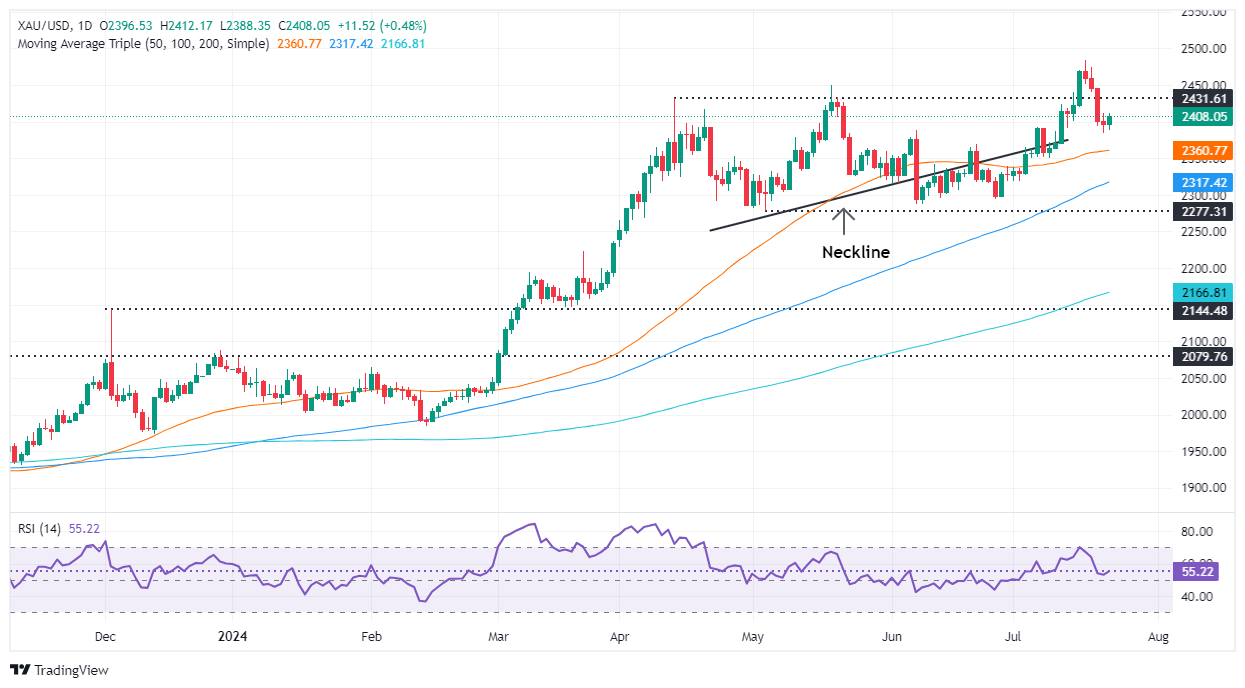- Gold price climbs above $2,400, ending a four-day losing streak amid falling US Treasury yields.
- Traders await crucial economic data, including June’s inflation and Q2 GDP, to gauge the Fed’s next move.
- India’s import tax cut on gold and silver boosts retail demand, supporting bullion prices.
Gold price recovered in the mid-North American session, boosted by a drop in US Treasury bond yields. This pushed the Greenback lower amid a busy Us economic docket in the week, which will feature crucial data. The XAU/USD trades at $2,404, up by 0.33%.
Wall Street trades with gains for the second straight day as market players digest last weekend's political developments in the US. Market players are eyeing the release of June’s inflation data and the preliminary reading of the Gross Domestic Product (GDP) for the second quarter of 2024.
The non-yielding metals are ending a four-day streak of losses as market participants await the Fed's first interest rate cut, according to a Reuters poll. The survey showed that 73 of 100 economists expect Powell and Co. to ease policy by 50 basis points (bps) in 2024, with 13 expecting 25 bps and three expecting no cuts.
Traders speculate the first 25 bps rate cut will be in September, as shown by the CME FedWatch Tool, with odds at 96%.
In the meantime, the US 10-year Treasury bond yield falls one and a half bps to 4.24%, a tailwind for the precious metal.
The Core Personal Consumption Expenditures (PCE) Price Index could be the last piece of the puzzle for Fed officials to begin relaxing policy. Sources cited by Reuters commented, “Anything weaker than expected (PCE data) would be a positive, mainly because it would convince the markets that the U.S. central bank is easing monetary policy in September.”
Bullion was also boosted by India’s slashing import taxes on Gold and Silver, which could lift retail demand.
The US Dollar Index (DXY), which tracks the currency's performance against six other currencies, aims up 0.17% at 104.45. This kept Gold prices glued to the $2,400 mark despite posting gains.
Daily digest market movers: Gold price recovers the $2,400 figure
- Gold traders are focused on the release of key economic data, including Durable Goods Orders, the preliminary Q2 GDP number, and the Core PCE for June.
- Durable Goods Orders are expected to increase from 0.1% to 0.4% month-over-month (MoM).
- The Gross Domestic Product (GDP) for Q2 is projected to rise from 1.4% in Q1 2024 to 1.9% quarter-over-quarter (QoQ), indicating that the economy is accelerating as the year progresses.
- The Fed’s preferred measure of inflation, the Core PCE, is expected to dip from 2.6% to 2.5% year-over-year (YoY).
- The latest Consumer Price Index (CPI) data revealed a continuation of the disinflation process in the United States (US), boosting gold prices and increasing the likelihood that the Fed will cut interest rates starting in September.
- December 2024 fed funds rate futures contract implies that the Fed will ease policy by 50 basis points (bps) toward the end of the year, up from 48 a day ago.
Technical analysis: Gold price contained within Monday’s trading range
Gold price seems to have finished its losing streak, forming a ‘bullish harami,’ a two-candle pattern, hinting the uptrend could continue in the near term.
The Relative Strength Index (RSI) is bullish and indicates that buyers are gathering momentum, which could drive prices higher.
XAU/USD needs to clear Monday’s high at $2,412 for a bullish continuation. Once surpassed, the next resistance would be $2,450 before challenging the all-time high of $2,483. Up next would be the $2,500 figure.
Conversely, if XAU/USD tumbles below the July 22 low of $2,384, a deeper correction is on the cards. The next support would be the 50-day Simple Moving Average (SMA) at $2,359. Once sellers clear the 100-day SMA at $2,315, further losses are seen before falling toward $2,300.
Gold FAQs
Gold has played a key role in human’s history as it has been widely used as a store of value and medium of exchange. Currently, apart from its shine and usage for jewelry, the precious metal is widely seen as a safe-haven asset, meaning that it is considered a good investment during turbulent times. Gold is also widely seen as a hedge against inflation and against depreciating currencies as it doesn’t rely on any specific issuer or government.
Central banks are the biggest Gold holders. In their aim to support their currencies in turbulent times, central banks tend to diversify their reserves and buy Gold to improve the perceived strength of the economy and the currency. High Gold reserves can be a source of trust for a country’s solvency. Central banks added 1,136 tonnes of Gold worth around $70 billion to their reserves in 2022, according to data from the World Gold Council. This is the highest yearly purchase since records began. Central banks from emerging economies such as China, India and Turkey are quickly increasing their Gold reserves.
Gold has an inverse correlation with the US Dollar and US Treasuries, which are both major reserve and safe-haven assets. When the Dollar depreciates, Gold tends to rise, enabling investors and central banks to diversify their assets in turbulent times. Gold is also inversely correlated with risk assets. A rally in the stock market tends to weaken Gold price, while sell-offs in riskier markets tend to favor the precious metal.
The price can move due to a wide range of factors. Geopolitical instability or fears of a deep recession can quickly make Gold price escalate due to its safe-haven status. As a yield-less asset, Gold tends to rise with lower interest rates, while higher cost of money usually weighs down on the yellow metal. Still, most moves depend on how the US Dollar (USD) behaves as the asset is priced in dollars (XAU/USD). A strong Dollar tends to keep the price of Gold controlled, whereas a weaker Dollar is likely to push Gold prices up.
Information on these pages contains forward-looking statements that involve risks and uncertainties. Markets and instruments profiled on this page are for informational purposes only and should not in any way come across as a recommendation to buy or sell in these assets. You should do your own thorough research before making any investment decisions. FXStreet does not in any way guarantee that this information is free from mistakes, errors, or material misstatements. It also does not guarantee that this information is of a timely nature. Investing in Open Markets involves a great deal of risk, including the loss of all or a portion of your investment, as well as emotional distress. All risks, losses and costs associated with investing, including total loss of principal, are your responsibility. The views and opinions expressed in this article are those of the authors and do not necessarily reflect the official policy or position of FXStreet nor its advertisers. The author will not be held responsible for information that is found at the end of links posted on this page.
If not otherwise explicitly mentioned in the body of the article, at the time of writing, the author has no position in any stock mentioned in this article and no business relationship with any company mentioned. The author has not received compensation for writing this article, other than from FXStreet.
FXStreet and the author do not provide personalized recommendations. The author makes no representations as to the accuracy, completeness, or suitability of this information. FXStreet and the author will not be liable for any errors, omissions or any losses, injuries or damages arising from this information and its display or use. Errors and omissions excepted.
The author and FXStreet are not registered investment advisors and nothing in this article is intended to be investment advice.
Recommended content
Editors’ Picks

EUR/USD extends slide below 1.0300, touches new two-year low
EUR/USD stays under bearish pressure and trades at its lowest level since November 2022, below 1.0300 on Thursday. The US Dollar benefits from the risk-averse market atmosphere and the upbeat Jobless Claims data, causing the pair to stretch lower.

GBP/USD slumps to multi-month lows below 1.2400 on broad USD strength
Following an earlier recovery attempt, GBP/USD reversed its direction and declined to its weakest level in nearly eight months below 1.2400. The renewed US Dollar (USD) strength on worsening risk mood weighs on the pair as trading conditions normalize after the New Year break.

Gold benefits from risk aversion, climbs above $2,650
Gold gathers recovery momentum and trades at a two-week-high above $2,650 in the American session on Thursday. The precious metal benefits from the sour market mood and the pullback seen in the US Treasury bond yields.

These 5 altcoins are rallying ahead of $16 billion FTX creditor payout
FTX begins creditor payouts on January 3, in agreement with BitGo and Kraken, per an official announcement. Bonk, Fantom, Jupiter, Raydium and Solana are rallying on Thursday, before FTX repayment begins.

Three Fundamentals: Year-end flows, Jobless Claims and ISM Manufacturing PMI stand out Premium
Money managers may adjust their portfolios ahead of the year-end. Weekly US Jobless Claims serve as the first meaningful release in 2025. The ISM Manufacturing PMI provides an initial indication ahead of Nonfarm Payrolls.

Best Forex Brokers with Low Spreads
VERIFIED Low spreads are crucial for reducing trading costs. Explore top Forex brokers offering competitive spreads and high leverage. Compare options for EUR/USD, GBP/USD, USD/JPY, and Gold.
